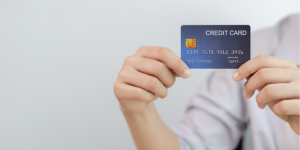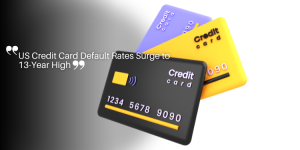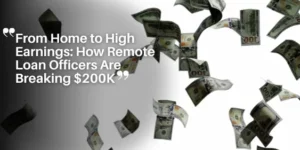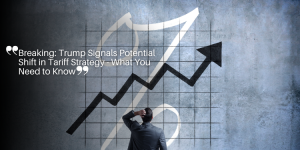New Credit Card Fees: What Changed in 2025 and How It Affects You
Recent Changes in Credit Card Rates in the U.S. 💳📈
2025 has brought significant shifts in the landscape of credit card interest rates in the United States.
Financial institutions have adjusted their approaches due to economic pressures, leading to some striking changes in the terms offered to consumers.
A notable outcome is the rise in interest rates, with some reaching as high as 29% annually for high-risk clients.
This marks a significant rise compared to earlier years and reflects the current economic climate and policies in place.

Record Levels of Credit Card Debt 💰📊
Compounding the impact of these high-interest rates is the unprecedented amount of credit card debt in the U.S. By the end of 2024, consumers faced an unprecedented $1.2 trillion in credit card debt.
This increase is mainly due to the ongoing economic challenges faced by many Americans, who have increasingly relied on credit to manage their daily expenses.
As inflation persists and costs of living soar, the reliance on credit cards grows, further exacerbating overall debt levels.
These elements combined create a challenging scenario where consumers are burdened with high interest rates and substantial debt, posing significant financial risks and influencing spending habits.
As we continue, it’s essential to understand what’s driving these changes and how they impact different groups of consumers.
Why Are Rates Rising 📈❓
Role of the Federal Reserve 🏦
The role of the Federal Reserve in increasing interest rates has been pivotal since 2022.
To combat accelerating inflation, the Fed has implemented several rate hikes.
These measures aim to cool down the overheating economy by making borrowing more expensive and thus slowing down consumer spending.
When inflation hit a notable high, averaging around 8% in 2022, the Fed decided to step in aggressively.
Direct Impact of Fed Decisions ⚖️
The decisions made by the Federal Reserve have a direct effect on the interest rates set by banks, including the rates applied to credit cards.
As the Fed raised its benchmark interest rates, banks followed suit, increasing their own rates to maintain a profitable margin.
Consequently, consumers today face significantly higher Annual Percentage Rates (APRs) on their credit cards. This means borrowing costs are now much steeper, which affects daily financial activities and planning.
Relationship Between Inflation and Rate Adjustment 🔄
Persistent inflation has been a critical factor behind the adjustment of credit card rates.
As prices keep climbing, consumers are finding themselves relying more on credit to manage everyday expenses, leading to increased balances on credit cards.
This reliance on credit creates a cyclical pattern where high debt levels push banks to demand greater returns to offset the increased risk of defaults.
Essentially, as inflation drives prices up, the cost of credit similarly increases, creating a challenging environment for those managing existing debts or looking to borrow more.
As we navigate through these economic changes, understanding the intertwined roles of the Federal Reserve’s policies and inflation can provide insights into why our current financial landscape has evolved this way.
New Interest Rates: Numbers and Comparisons 💸📊
Current Interest Rates 📉
The USA has seen a significant jump in credit card interest rates in recent years.
As of 2025, the average Annual Percentage Rate (APR) ranges from 24% to 29% annually.
This is substantially higher than previous years, where rates generally hovered around 18% to 22%.
The rapid increase in interest rates is directly linked to the Federal Reserve’s strategic decisions to combat inflation, propelling credit costs to new heights.
Comparative Analysis 🔍
When comparing credit card interest rates with other forms of credit, the differences are stark.
For instance, personal loans typically have interest rates ranging from 10% to 15%, and auto loans average around 4% to 9% annually.
These lower rates make other types of credit more appealing for large purchases or debt consolidation, steering clear of the steep costs linked to credit cards debt.
Practical Example 💡
Consider a balance of $1,000 on a credit card with a 28% interest rate.
If the balance isn’t paid off quickly, the debt can grow exponentially.
For example, with the compounding interest, this balance could swell to $1,280 in just one year if only minimum payments are made.
This illustrates the pressing need for consumers to manage and plan their credit card usage carefully to avoid falling into a debt trap.
The impact of these rising interest rates and comparisons with other forms of credit underscores the challenging environment consumers face today.
As rates climb, more individuals may reconsider their reliance on credit card debt and explore alternative financial solutions.
Who is Most Affected by the New Taxes 🧐
Impact on Subprime Consumers🔴
The recent increase in credit card interest rates disproportionately affects consumers with subprime credit scores.
These individuals, often viewed as having a higher risk of default, are subjected to higher interest rates, in some cases reaching up to 29% annually.
These higher rates make it harder for subprime borrowers to pay off their debts, causing balances to grow rapidly due to compounded interest.
Difficulties for Those Carrying Balances 💳💥
For those who carry a balance month-to-month on their credit cards, the financial strain can be significant.
Even a seemingly manageable balance can escalate quickly. For example, a $1,000 balance on a card with a 28% interest rate can grow severely if not managed promptly.
As interest accrues, the cost of monthly payments increases, making it harder to reduce the principal amount owed.
Increased Risk of Default ⚠️
The risk of default rises as interest rates climb.
Consumers struggling to make minimum payments may fall into a cycle of debt, where paying off the balance becomes nearly impossible.
This ongoing issue contributes to the growing national credit card debt, which reached a record $1.2 trillion by the end of 2024.
These financial challenges prompt the need for debt management strategies and alternative financial solutions.
Within this landscape of increasing rates, consumers will need to adapt to maintain financial health and stability.
Financial Institutions Strategies 🏦💡
Attracting Consumers with Incentives 🎁
As credit card interest rates surge due to economic pressures, financial institutions are deploying strategic offers to attract and retain customers.
Several banks have ramped up their offerings with travel benefits and cashback rewards to make their cards more appealing.
These incentives are crafted to balance the high cost of borrowing with attractive perks, hoping to encourage usage despite steeper rates.
-
Travel Rewards ✈️: Many new credit cards offer miles, hotel points, or airline tickets as rewards. These cards often include enticing sign-up bonuses and enhanced rewards rates to capture consumer interest.
-
Cashback Offers 💸: Cashback cards are being boosted with higher percentage returns on everyday spending categories like groceries and dining. This can effectively reduce the overall impact of the higher interest charged on balances.
Introducing Lower Interest Options 🔽
Feature Description 🔒 Lower APR Cards New credit cards are offering a lower fixed APR than the industry average, appealing to customers focused on reducing borrowing costs rather than earning rewards. 🔄 Balance Transfer Promotions These cards provide promotional periods where balance transfers incur minimal or no interest, allowing consumers to consolidate debt and potentially lower total interest paid over time.
Balancing High Rates with Incentives ⚖️💳
Institutions face the challenge of maintaining profitability while attracting new customers amid high interest rates.
The balance between higher costs for consumers and reward incentives is delicate but crucial.
Comprehensive Rewards Programs 🎁
Banks are not only offering travel and cashback perks but are also integrating broader rewards programs.
These might include retail discounts, exclusive event experiences, and loyalty bonuses, enhancing the value proposition for the consumer.
Bundling Services 💼📦
Some institutions are bundling credit cards with other financial products like savings accounts and personal loans.
By offering better rates and terms for multiple products, they can entice customers to stay within their ecosystem despite high credit card interest rates.
As the interest rate landscape evolves, these strategies reflect a dynamic approach by financial institutions to retain customer loyalty while navigating economic challenges.
The next topic will delve into alternative solutions and proactive measures consumers can adopt in response to these financial shifts.
Alternatives and Solutions for Consumers 💡🔑
It’s clear that consumers are facing some financial headwinds with credit card interest rates hitting new highs.
To navigate these challenges, it’s essential to look at the available alternatives and solutions.
Personal Loans with Lower Rates 💵
One viable option is personal loans, which generally provide much lower interest rates than credit cards.
While credit card APRs can reach up to 29%, personal loans typically range from 10% to 15%.
Launching into a personal loan might just be the ticket for consumers trying to consolidate high-interest credit card debt into easier-to-handle monthly installments.
Benefits of Low APR or Balance Transfer Cards 🔄
Credit cards with a fixed low APR can be a lifesaver, especially under current circumstances.
Some financial institutions are rolling out these kinds of cards to lure in cautious consumers.
Another smart strategy is taking advantage of balance transfer offers.
These promotional deals often come with zero or very low interest for a set period, like 12 to 18 months.
Shifting your current debt to one of these cards can buy you some breathing space to pay down the balance without accruing more interest.
Shifts in Consumer Behavior: Cash Payments and Credit Reduction 💵🚫
With the current economic conditions, changing how you use credit can have a positive financial impact.
Many consumers are moving towards paying in cash and reducing their reliance on credit altogether.
This shift can prevent the accumulation of high-interest debt and help in maintaining better control over personal finances.
As consumers adjust to the new credit landscape, these alternatives offer practical solutions to mitigate the strain of steep credit card interest rates.
Keeping an eye on financial habits and exploring lower-cost borrowing options are critical steps in navigating this challenging environment.
Don’t worry, the financial world keeps evolving, and adjusting to these shifts can result in more stable and smart money management. 🧠
Long-Term Impact on Personal Finances 📉🔮
Consequences for Credit Scores📊
The rising credit card interest rates have far-reaching implications for consumers, particularly those already burdened with debt.
Higher rates increase the likelihood of missed or late payments, negatively impacting credit scores.
A lower credit score can make borrowing more expensive and limit access to favorable credit terms in the future.
For consumers finding it hard to manage growing debt, the cycle of missed payments and high-interest accrual can be devastating. 💔
Changes in Consumption Habits and Adoption of More Cautious Financial Practices💳🚫
As consumers realize the increasing costs associated with credit card use, there’s a notable shift in spending behavior towards more conservative practices.
People are gradually cutting back on using their credit cards for everyday purchases and opting for alternatives such as personal loans with lower interest rates or choosing to pay with cash.
This cautious approach helps in managing personal finances better and avoiding the debt trap.
Possible Economic Slowdown Due to Reduced Consumer Spending 📉💡
The broader economic impact of these shifts can’t be overlooked. As consumers cut back on their spending, there’s a ripple effect on the economy.
A decline in consumer spending can result in slower economic growth, affecting businesses and potentially leading to unemployment or reduced wages.
This creates a feedback loop where economic uncertainty further discourages spending, contributing to a sluggish economic environment.
These shifts underline the need for more strategic financial decisions by consumers and thoughtful responses from financial institutions.
Grasping the intricacies of this shift aids in framing better policies and informing consumers about smarter financial habits.
What to Expect for the Future 🔜
Projected Interest Rate Trends 📊
As we look towards the future, interest rates for credit cards are likely to remain high, reflecting the Federal Reserve’s ongoing efforts to combat inflation.
While the peak in 2025 has seen credit card APRs soar to between 24% and 29% annually for higher-risk customers, these rates may not decrease significantly in the short term.
Consumers should anticipate a continued tight monetary policy stance from the Fed as they aim to stabilize the economy and reduce inflationary pressures.
Potential Shifts in Fed Policies 🏛️📉
The Federal Reserve’s policies will continue to play a crucial factor in setting credit card interest rates.
Given the persistent inflation, the Fed may choose to maintain elevated interest rates or even introduce incremental hikes if inflation does not recede as expected.
Conversely, should the economy show signs of marked improvement and inflation rates dip within target ranges, a gradual reduction of interest rates might be on the horizon. However, any changes will be cautious and based on robust economic indicators.
Preparing for Financial Challenges in 2026 🗓️💪
To prepare for the financial landscape of 2026, consumers should adopt several strategies:
-
Monitor Economic Indicators: Stay informed about Federal Reserve Statements and economic metrics like inflation rates and employment statistics. This can help anticipate shifts in interest rates and make proactive financial decisions.
-
Focus on Reducing Debt: Given the high costs associated with credit card debt, prioritizing debt repayment can mitigate future financial stress. This includes making more than the minimum payments and considering balance transfer offers with lower promotional rates.
-
Explore Alternative Credit Options: Personal loans typically have lower interest rates than credit cards and could be a viable alternative for large expenses or debt consolidation.
-
Adjust Spending Habits: Adopting conservative spending practices, such as opting for cash payments and avoiding unnecessary credit card use, can help in maintaining financial stability amid uncertain economic conditions.
These proactive steps can help consumers navigate the complexities of the evolving credit card landscape and better prepare for potential economic shifts in the future. 🧭







